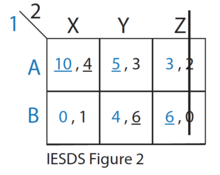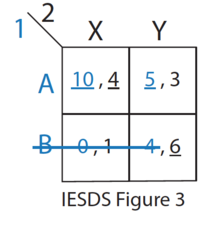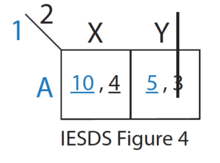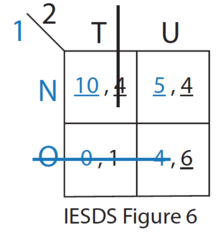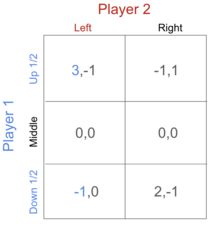297:
357:). When player 2 plays left, then the payoff for player 1 playing the mixed strategy of up and down is 1, when player 2 plays right, the payoff for player 1 playing the mixed strategy is 0.5. Thus regardless of whether player 2 chooses left or right, player 1 gets more from playing this mixed strategy between up and down than if the player were to play the middle strategy. In this case, we should eliminate the middle strategy for player 1 since it's been dominated by the mixed strategy of playing up and down with probability (
404:
1003:. Consider the game on the right with payoffs of the column player omitted for simplicity. Notice that "b" is not strictly dominated by either "t" or "m" in the pure strategy sense, but it is still dominated by a strategy that would mix "t" and "m" with probability of each equal to 1/2. This is due to the fact that given any belief about the action of the column player, the mixed strategy will always yield higher expected payoff. This implies that "b" is not rationalizable.
204:
251:
199:
194:
209:
266:
186:
166:
removing dominated strategies. In the first step, at most one dominated strategy is removed from the strategy space of each of the players since no rational player would ever play these strategies. This results in a new, smaller game. Some strategies—that were not dominated before—may be dominated in
174:
There are two versions of this process. One version involves only eliminating strictly dominated strategies. If, after completing this process, there is only one strategy for each player remaining, that strategy set is the unique Nash equilibrium. Moreover, iterated elimination of strictly dominated
1010:
to either "L" or "R" or any mix of the two. This is because an action that is not rationalizable can never be a best response to any opponent's strategy (pure or mixed). This would imply another version of the previous method of finding rationalizable strategies as those that survive the iterated
291:
There are instances when there is no pure strategy that dominates another pure strategy, but a mixture of two or more pure strategies can dominate another strategy. This is called
Strictly Dominant Mixed Strategies. Some authors allow for elimination of strategies dominated by a mixed strategy in
113:. Both require players to respond optimally to some belief about their opponents' actions, but Nash equilibrium requires these beliefs to be correct, while rationalizability does not. Rationalizability was first defined, independently, by Bernheim (1984) and Pearce (1984).
1014:
In games with more than two players, however, there may be strategies that are not strictly dominated, but which can never be the best response. By the iterated elimination of all such strategies one can find the rationalizable strategies for a multiplayer game.
1023:
It can be easily proved that a Nash equilibrium is a rationalizable equilibrium; however, the converse is not true. Some rationalizable equilibria are not Nash equilibria. This makes the rationalizability concept a generalization of Nash equilibrium concept.
167:
the smaller game. The first step is repeated, creating a new even smaller game, and so on. The process stops when no dominated strategy is found for any player. This process is valid since it is assumed that rationality among players is
171:, that is, each player knows that the rest of the players are rational, and each player knows that the rest of the players know that he knows that the rest of the players are rational, and so on ad infinitum (see Aumann, 1976).
998:
Conversely, for two-player games, the set of all rationalizable strategies can be found by iterated elimination of strictly dominated strategies. For this method to hold however, one also needs to consider strict domination by
235:. However, unlike the first process, elimination of weakly dominated strategies may eliminate some Nash equilibria. As a result, the Nash equilibrium found by eliminating weakly dominated strategies may not be the
175:
strategies is path independent. That is, if at any point in the process there are multiple strictly dominated strategies, then it doesn't matter for the end result which strategies we remove first.
400:
We can demonstrate the same methods on a more complex game and solve for the rational strategies. In this scenario, the blue coloring represents the dominating numbers in the particular strategy.
136:, i.e. strategies that "never make sense" (are never a best reply to any belief about the opponents' actions). The motivation for this step is no rational player would ever choose such actions.
231:
Another version involves eliminating both strictly and weakly dominated strategies. If, at the end of the process, there is a single strategy for each player, this strategy set is also a
106:. A strategy is rationalizable if there exists some possible set of beliefs both players could have about each other's actions, that would still result in the strategy being played.
162:
The iterated elimination (or deletion, or removal) of dominated strategies (also denominated as IESDS, or IDSDS, or IRSDS) is one common technique for solving games that involves
218:
Of the remaining strategies (see IESDS Figure 2), Z is strictly dominated by Y and X for Player 2. Therefore, Player 2 will never play strategy Z. Player 1 knows this.
309:
In this scenario, for player 1, there is no pure strategy that dominates another pure strategy. Let's define the probability of player 1 playing up as p, and let p =
154:
In a game with finitely many actions, this process always terminates and leaves a non-empty set of actions for each player. These are the rationalizable actions.
224:
Of the remaining strategies (see IESDS Figure 4), Y is strictly dominated by X for Player 2. Therefore, Player 2 will never play Y. Player 1 knows this.
221:
Of the remaining strategies (see IESDS Figure 3), B is strictly dominated by A for Player 1. Therefore, Player 1 will never play B. Player 2 knows this.
239:
Nash equilibrium. (In some games, if we remove weakly dominated strategies in a different order, we may end up with a different Nash equilibrium.)
528:
as tester values. The argument for mixed strategy dominance can be made if there is at least one mixed strategy that allows for dominance.
279:
In any case, if by iterated elimination of dominated strategies there is only one strategy left for each player, the game is called a
227:
Only one rationalizable strategy is left {A,X} which results in a payoff of (10,4). This is the single Nash
Equilibrium for this game.
272:
O is strictly dominated by N for Player 1. Therefore, Player 1 will never play strategy O. Player 2 knows this. (see IESDS Figure 6)
257:
O is strictly dominated by N for Player 1. Therefore, Player 1 will never play strategy O. Player 2 knows this. (see IESDS Figure 5)
215:
C is strictly dominated by A for Player 1. Therefore, Player 1 will never play strategy C. Player 2 knows this. (see IESDS Figure 1)
1307:
2206:
640:
Set up the inequality to determine whether the mixed strategy will dominate the pure strategy based on expected payoffs.
2023:
1558:
1356:
722:
Z will dominate pure strategy X for Player 2, and thus X can be eliminated from the rationalizable strategies for P2.
1842:
1661:
1189:
1463:
1932:
1802:
1473:
1641:
1983:
1401:
1376:
1135:(beginning the cycle again). This provides an infinite set of consistent beliefs that results in row playing
46:
2333:
1759:
1513:
1503:
1438:
1553:
1533:
1160:
2267:
2018:
1988:
1646:
1488:
1483:
98:. It is the most permissive possible solution concept that still requires both players to be at least
2303:
2226:
1962:
1518:
1443:
1300:
2318:
2051:
1937:
1734:
1528:
1346:
1203:
275:
T is weakly dominated by U for Player 2. If Player 2 chooses U, then the final equilibrium is (N,U)
260:
U is weakly dominated by T for Player 2. If Player 2 chooses T, then the final equilibrium is (N,T)
168:
2121:
2323:
1922:
1892:
1548:
1336:
296:
2348:
2328:
2308:
2257:
1927:
1832:
1691:
1636:
1568:
1538:
1458:
1386:
1000:
1280:
1807:
1792:
1366:
923:
846:
2369:
2141:
2126:
2013:
2008:
1912:
1897:
1862:
1827:
1426:
1371:
1293:
103:
895:
This provides an infinite chain of consistent beliefs that result in the players playing (
8:
2298:
1917:
1867:
1704:
1631:
1611:
1468:
1351:
1165:
133:
1957:
2277:
2136:
1967:
1947:
1797:
1676:
1581:
1508:
1453:
1184:
Joel., Watson,. Strategy : an introduction to game theory (Second ed.). New York.
2262:
2231:
2186:
2081:
1952:
1907:
1882:
1812:
1686:
1616:
1606:
1498:
1448:
1396:
1222:
1185:
798:
748:
735:
829:
if it is reasonable for the column player to believe that the row player could play
2343:
2338:
2272:
2236:
2216:
2176:
2146:
2101:
2056:
2041:
1998:
1852:
1493:
1430:
1416:
1381:
1272:
Pearce, D. (1984) Rationalizable
Strategic Behavior and the Problem of Perfection.
1218:
1077:
1011:
elimination of strategies that are never a best response (in pure or mixed sense).
325:. We can set a mixed strategy where player 1 plays up and down with probabilities (
232:
139:
Remove all actions which are never a best reply to any belief about the opponents'
122:
110:
91:
79:
56:
27:
496:
Z must be greater than the expected payoff for playing pure strategy X, assigning
102:
and know the other players are also somewhat rational, i.e. that they do not play
2241:
2201:
2156:
2071:
2066:
1787:
1739:
1626:
1391:
1361:
1331:
2106:
157:
2181:
2171:
2161:
2096:
2086:
2076:
2061:
1857:
1837:
1822:
1817:
1777:
1744:
1729:
1724:
1714:
1523:
934:
is not a best response to any strategy by the column player. For this reason,
2363:
2221:
2211:
2166:
2151:
2131:
1902:
1877:
1749:
1719:
1709:
1696:
1601:
1543:
1478:
1411:
1097:
1080:
pictured to the right. In this game the only Nash equilibrium is row playing
1007:
818:
802:
403:
2196:
2191:
2046:
1621:
911:) a rationalizable pair of actions. A similar process can be repeated for (
2313:
2116:
2111:
2091:
1887:
1872:
1681:
1651:
1586:
1576:
1406:
1341:
1317:
1262:
1026:
940:
745:
95:
31:
1285:
843:
1942:
1596:
922:
As an example where not all strategies are rationalizable, consider a
1847:
1767:
1591:
163:
208:
203:
2282:
1782:
99:
2003:
1993:
1671:
265:
250:
198:
193:
125:, the rationalizable set of actions can be computed as follows:
150:
Continue the process until no further actions can be eliminated.
809:
if he can reasonably believe that the column player could play
1772:
1279:
Ratcliff, J. (1992–1997) lecture notes on game theory, §2.2:
1123:
if it is reasonable for her to believe that column will play
1107:
if it is reasonable for her to believe that column will play
158:
Iterated elimination of strictly dominated strategies (IESDS)
825:. He can reasonably believe that the column player can play
185:
1131:
if it is reasonable for him to believe that row will play
837:
if it is reasonable for her to believe that he could play
143:
actions—this second step is justified because each player
636:
Expected average payoff of pure strategy X: (1+1+3) = 5
286:
1115:
if its reasonable for him to believe that row will play
1018:
1254:
Bernheim, D. (1984) Rationalizable
Strategic Behavior.
738:
strategy for
Players 1 and 2 is then (M,Z) or (3,5).
728:
For player 2, Y is dominated by the pure strategy Z.
725:
For Player 1, U is dominated by the pure strategy D.
429:For Player 2, X is dominated by the mixed strategy
1204:"On the order of eliminating dominated strategies"
1139:. A similar argument can be given for row playing
926:pictured to the left. Row player would never play
2361:
1201:
1103:Consider the following reasoning: row can play
180:Strict Dominance Deletion Step-by-Step Example:
129:Start with the full action set for each player.
109:Rationalizability is a broader concept than a
1301:
244:Weak Dominance Deletion Step-by-Step Example:
402:
184:
1308:
1294:
1281:"Iterated Dominance and Rationalizability"
1088:with equal probability and column playing
805:is to the right). The row player can play
295:
264:
249:
207:
202:
197:
192:
1315:
1202:Gilboa, I.; Kalai, E.; Zemel, E. (1990).
741:
731:This leaves M dominating D for Player 1.
464:The expected payoff for playing strategy
1235:
2362:
1229:
287:Iterated elimination by mixed strategy
1289:
1096:with equal probability. However, all
1019:Rationalizability and Nash equilibria
833:. She can believe that he will play
147:that the other players are rational.
13:
1357:First-player and second-player win
14:
2381:
1100:in this game are rationalizable.
1076:As an example, consider the game
1027:
844:
746:
1464:Coalition-proof Nash equilibrium
1143:, and for column playing either
16:Solution concept in game theory
1474:Evolutionarily stable strategy
1195:
1178:
1:
1402:Simultaneous action selection
1248:
116:
47:Dominant strategy equilibrium
2334:List of games in game theory
1514:Quantal response equilibrium
1504:Perfect Bayesian equilibrium
1439:Bayes correlated equilibrium
1223:10.1016/0167-6377(90)90046-8
1171:
7:
1803:Optional prisoner's dilemma
1534:Self-confirming equilibrium
1211:Operations Research Letters
1161:Self-confirming equilibrium
1154:
601:Expected average payoff of
566:Expected average payoff of
10:
2386:
2268:Principal variation search
1984:Aumann's agreement theorem
1647:Strategy-stealing argument
1559:Trembling hand equilibrium
1489:Markov perfect equilibrium
1484:Mertens-stable equilibrium
2304:Combinatorial game theory
2291:
2250:
2032:
1976:
1963:Princess and monster game
1758:
1660:
1567:
1519:Quasi-perfect equilibrium
1444:Bayesian Nash equilibrium
1425:
1324:
75:
71:D. Bernheim and D. Pearce
67:
62:
52:
42:
37:
26:
21:
2319:Evolutionary game theory
2052:Antoine Augustin Cournot
1938:Guess 2/3 of the average
1735:Strictly determined game
1529:Satisfaction equilibrium
1347:Escalation of commitment
1236:Gibbons, Robert (1992).
2324:Glossary of game theory
1923:Stackelberg competition
1549:Strong Nash equilibrium
1238:A Primer in Game Theory
1006:Moreover, "b" is not a
938:is not rationalizable.
2349:Tragedy of the commons
2329:List of game theorists
2309:Confrontation analysis
2019:Sprague–Grundy theorem
1539:Sequential equilibrium
1459:Correlated equilibrium
742:Constraints on beliefs
426:Step-by-step solving:
407:
189:
2122:Jean-François Mertens
1269:Cambridge: MIT Press.
563:gets the following:
406:
188:
2251:Search optimizations
2127:Jennifer Tour Chayes
2014:Revelation principle
2009:Purification theorem
1948:Nash bargaining game
1913:Bertrand competition
1898:El Farol Bar problem
1863:Electronic mail game
1828:Lewis signaling game
1372:Hierarchy of beliefs
1261:Fudenberg, Drew and
134:dominated strategies
104:dominated strategies
2299:Bounded rationality
1918:Cournot competition
1868:Rock paper scissors
1843:Battle of the sexes
1833:Volunteer's dilemma
1705:Perfect information
1632:Dominant strategies
1469:Epsilon-equilibrium
1352:Extensive-form game
1166:Strategic dominance
1031:
850:
752:
2278:Paranoid algorithm
2258:Alpha–beta pruning
2137:John Maynard Smith
1968:Rendezvous problem
1808:Traveler's dilemma
1798:Gift-exchange game
1793:Prisoner's dilemma
1710:Large Poisson game
1677:Bargaining problem
1582:Backward induction
1554:Subgame perfection
1509:Proper equilibrium
1127:. Column can play
1111:. Column can play
924:prisoner's dilemma
847:Prisoner's Dilemma
797:Consider a simple
408:
281:dominance-solvable
190:
2357:
2356:
2263:Aspiration window
2232:Suzanne Scotchmer
2187:Oskar Morgenstern
2082:Donald B. Gillies
2024:Zermelo's theorem
1953:Induction puzzles
1908:Fair cake-cutting
1883:Public goods game
1813:Coordination game
1687:Intransitive game
1617:Forward induction
1499:Pareto efficiency
1479:Gibbs equilibrium
1449:Berge equilibrium
1397:Simultaneous game
1240:. pp. 32–33.
1074:
1073:
996:
995:
893:
892:
799:coordination game
795:
794:
749:Coordination game
100:somewhat rational
88:Rationalizability
85:
84:
22:Rationalizability
2377:
2344:Topological game
2339:No-win situation
2237:Thomas Schelling
2217:Robert B. Wilson
2177:Merrill M. Flood
2147:John von Neumann
2057:Ariel Rubinstein
2042:Albert W. Tucker
1893:War of attrition
1853:Matching pennies
1494:Nash equilibrium
1417:Mechanism design
1382:Normal-form game
1337:Cooperative game
1310:
1303:
1296:
1287:
1286:
1242:
1241:
1233:
1227:
1226:
1208:
1199:
1193:
1182:
1078:matching pennies
1032:
1029:Matching pennies
1001:mixed strategies
941:
851:
753:
721:
719:
718:
715:
712:
705:
703:
702:
699:
696:
678:
676:
675:
672:
669:
659:
657:
656:
653:
650:
632:
630:
629:
626:
623:
616:
614:
613:
610:
607:
597:
595:
594:
591:
588:
581:
579:
578:
575:
572:
562:
560:
559:
556:
553:
546:
544:
543:
540:
537:
527:
525:
524:
521:
518:
511:
509:
508:
505:
502:
495:
493:
492:
489:
486:
479:
477:
476:
473:
470:
460:
458:
457:
454:
451:
444:
442:
441:
438:
435:
388:
386:
385:
382:
379:
372:
370:
369:
366:
363:
356:
354:
353:
350:
347:
340:
338:
337:
334:
331:
324:
322:
321:
318:
315:
299:
268:
253:
233:Nash equilibrium
211:
206:
201:
196:
169:common knowledge
123:normal-form game
121:Starting with a
111:Nash equilibrium
92:solution concept
80:Matching pennies
57:Nash equilibrium
28:Solution concept
19:
18:
2385:
2384:
2380:
2379:
2378:
2376:
2375:
2374:
2360:
2359:
2358:
2353:
2287:
2273:max^n algorithm
2246:
2242:William Vickrey
2202:Reinhard Selten
2157:Kenneth Binmore
2072:David K. Levine
2067:Daniel Kahneman
2034:
2028:
2004:Negamax theorem
1994:Minimax theorem
1972:
1933:Diner's dilemma
1788:All-pay auction
1754:
1740:Stochastic game
1692:Mean-field game
1663:
1656:
1627:Markov strategy
1563:
1429:
1421:
1392:Sequential game
1377:Information set
1362:Game complexity
1332:Congestion game
1320:
1314:
1251:
1246:
1245:
1234:
1230:
1206:
1200:
1196:
1183:
1179:
1174:
1157:
1119:. Row can play
1098:pure strategies
1021:
903:). This makes (
744:
716:
713:
710:
709:
707:
700:
697:
694:
693:
691:
690:Mixed strategy
684:
680:
673:
670:
667:
666:
664:
661:
654:
651:
648:
647:
645:
639:
627:
624:
621:
620:
618:
611:
608:
605:
604:
602:
592:
589:
586:
585:
583:
576:
573:
570:
569:
567:
557:
554:
551:
550:
548:
541:
538:
535:
534:
532:
522:
519:
516:
515:
513:
506:
503:
500:
499:
497:
490:
487:
484:
483:
481:
474:
471:
468:
467:
465:
455:
452:
449:
448:
446:
439:
436:
433:
432:
430:
425:
422:
419:
416:
413:
410:
392:
383:
380:
377:
376:
374:
367:
364:
361:
360:
358:
351:
348:
345:
344:
342:
335:
332:
329:
328:
326:
319:
316:
313:
312:
310:
289:
160:
119:
17:
12:
11:
5:
2383:
2373:
2372:
2355:
2354:
2352:
2351:
2346:
2341:
2336:
2331:
2326:
2321:
2316:
2311:
2306:
2301:
2295:
2293:
2289:
2288:
2286:
2285:
2280:
2275:
2270:
2265:
2260:
2254:
2252:
2248:
2247:
2245:
2244:
2239:
2234:
2229:
2224:
2219:
2214:
2209:
2207:Robert Axelrod
2204:
2199:
2194:
2189:
2184:
2182:Olga Bondareva
2179:
2174:
2172:Melvin Dresher
2169:
2164:
2162:Leonid Hurwicz
2159:
2154:
2149:
2144:
2139:
2134:
2129:
2124:
2119:
2114:
2109:
2104:
2099:
2097:Harold W. Kuhn
2094:
2089:
2087:Drew Fudenberg
2084:
2079:
2077:David M. Kreps
2074:
2069:
2064:
2062:Claude Shannon
2059:
2054:
2049:
2044:
2038:
2036:
2030:
2029:
2027:
2026:
2021:
2016:
2011:
2006:
2001:
1999:Nash's theorem
1996:
1991:
1986:
1980:
1978:
1974:
1973:
1971:
1970:
1965:
1960:
1955:
1950:
1945:
1940:
1935:
1930:
1925:
1920:
1915:
1910:
1905:
1900:
1895:
1890:
1885:
1880:
1875:
1870:
1865:
1860:
1858:Ultimatum game
1855:
1850:
1845:
1840:
1838:Dollar auction
1835:
1830:
1825:
1823:Centipede game
1820:
1815:
1810:
1805:
1800:
1795:
1790:
1785:
1780:
1778:Infinite chess
1775:
1770:
1764:
1762:
1756:
1755:
1753:
1752:
1747:
1745:Symmetric game
1742:
1737:
1732:
1730:Signaling game
1727:
1725:Screening game
1722:
1717:
1715:Potential game
1712:
1707:
1702:
1694:
1689:
1684:
1679:
1674:
1668:
1666:
1658:
1657:
1655:
1654:
1649:
1644:
1642:Mixed strategy
1639:
1634:
1629:
1624:
1619:
1614:
1609:
1604:
1599:
1594:
1589:
1584:
1579:
1573:
1571:
1565:
1564:
1562:
1561:
1556:
1551:
1546:
1541:
1536:
1531:
1526:
1524:Risk dominance
1521:
1516:
1511:
1506:
1501:
1496:
1491:
1486:
1481:
1476:
1471:
1466:
1461:
1456:
1451:
1446:
1441:
1435:
1433:
1423:
1422:
1420:
1419:
1414:
1409:
1404:
1399:
1394:
1389:
1384:
1379:
1374:
1369:
1367:Graphical game
1364:
1359:
1354:
1349:
1344:
1339:
1334:
1328:
1326:
1322:
1321:
1313:
1312:
1305:
1298:
1290:
1284:
1283:
1277:
1276:52: 1029–1050.
1270:
1259:
1258:52: 1007–1028.
1250:
1247:
1244:
1243:
1228:
1194:
1176:
1175:
1173:
1170:
1169:
1168:
1163:
1156:
1153:
1072:
1071:
1068:
1065:
1059:
1058:
1055:
1052:
1046:
1045:
1040:
1035:
1020:
1017:
994:
993:
990:
987:
981:
980:
977:
974:
968:
967:
964:
961:
955:
954:
949:
944:
891:
890:
887:
884:
878:
877:
874:
871:
865:
864:
859:
854:
793:
792:
789:
786:
780:
779:
776:
773:
767:
766:
761:
756:
743:
740:
736:rationalizable
687:4 + 5 > 5
682:
663:
644:
288:
285:
277:
276:
273:
262:
261:
258:
229:
228:
225:
222:
219:
216:
159:
156:
152:
151:
148:
137:
130:
118:
115:
83:
82:
77:
73:
72:
69:
65:
64:
60:
59:
54:
50:
49:
44:
40:
39:
35:
34:
24:
23:
15:
9:
6:
4:
3:
2:
2382:
2371:
2368:
2367:
2365:
2350:
2347:
2345:
2342:
2340:
2337:
2335:
2332:
2330:
2327:
2325:
2322:
2320:
2317:
2315:
2312:
2310:
2307:
2305:
2302:
2300:
2297:
2296:
2294:
2292:Miscellaneous
2290:
2284:
2281:
2279:
2276:
2274:
2271:
2269:
2266:
2264:
2261:
2259:
2256:
2255:
2253:
2249:
2243:
2240:
2238:
2235:
2233:
2230:
2228:
2227:Samuel Bowles
2225:
2223:
2222:Roger Myerson
2220:
2218:
2215:
2213:
2212:Robert Aumann
2210:
2208:
2205:
2203:
2200:
2198:
2195:
2193:
2190:
2188:
2185:
2183:
2180:
2178:
2175:
2173:
2170:
2168:
2167:Lloyd Shapley
2165:
2163:
2160:
2158:
2155:
2153:
2152:Kenneth Arrow
2150:
2148:
2145:
2143:
2140:
2138:
2135:
2133:
2132:John Harsanyi
2130:
2128:
2125:
2123:
2120:
2118:
2115:
2113:
2110:
2108:
2105:
2103:
2102:Herbert Simon
2100:
2098:
2095:
2093:
2090:
2088:
2085:
2083:
2080:
2078:
2075:
2073:
2070:
2068:
2065:
2063:
2060:
2058:
2055:
2053:
2050:
2048:
2045:
2043:
2040:
2039:
2037:
2031:
2025:
2022:
2020:
2017:
2015:
2012:
2010:
2007:
2005:
2002:
2000:
1997:
1995:
1992:
1990:
1987:
1985:
1982:
1981:
1979:
1975:
1969:
1966:
1964:
1961:
1959:
1956:
1954:
1951:
1949:
1946:
1944:
1941:
1939:
1936:
1934:
1931:
1929:
1926:
1924:
1921:
1919:
1916:
1914:
1911:
1909:
1906:
1904:
1903:Fair division
1901:
1899:
1896:
1894:
1891:
1889:
1886:
1884:
1881:
1879:
1878:Dictator game
1876:
1874:
1871:
1869:
1866:
1864:
1861:
1859:
1856:
1854:
1851:
1849:
1846:
1844:
1841:
1839:
1836:
1834:
1831:
1829:
1826:
1824:
1821:
1819:
1816:
1814:
1811:
1809:
1806:
1804:
1801:
1799:
1796:
1794:
1791:
1789:
1786:
1784:
1781:
1779:
1776:
1774:
1771:
1769:
1766:
1765:
1763:
1761:
1757:
1751:
1750:Zero-sum game
1748:
1746:
1743:
1741:
1738:
1736:
1733:
1731:
1728:
1726:
1723:
1721:
1720:Repeated game
1718:
1716:
1713:
1711:
1708:
1706:
1703:
1701:
1699:
1695:
1693:
1690:
1688:
1685:
1683:
1680:
1678:
1675:
1673:
1670:
1669:
1667:
1665:
1659:
1653:
1650:
1648:
1645:
1643:
1640:
1638:
1637:Pure strategy
1635:
1633:
1630:
1628:
1625:
1623:
1620:
1618:
1615:
1613:
1610:
1608:
1605:
1603:
1602:De-escalation
1600:
1598:
1595:
1593:
1590:
1588:
1585:
1583:
1580:
1578:
1575:
1574:
1572:
1570:
1566:
1560:
1557:
1555:
1552:
1550:
1547:
1545:
1544:Shapley value
1542:
1540:
1537:
1535:
1532:
1530:
1527:
1525:
1522:
1520:
1517:
1515:
1512:
1510:
1507:
1505:
1502:
1500:
1497:
1495:
1492:
1490:
1487:
1485:
1482:
1480:
1477:
1475:
1472:
1470:
1467:
1465:
1462:
1460:
1457:
1455:
1452:
1450:
1447:
1445:
1442:
1440:
1437:
1436:
1434:
1432:
1428:
1424:
1418:
1415:
1413:
1412:Succinct game
1410:
1408:
1405:
1403:
1400:
1398:
1395:
1393:
1390:
1388:
1385:
1383:
1380:
1378:
1375:
1373:
1370:
1368:
1365:
1363:
1360:
1358:
1355:
1353:
1350:
1348:
1345:
1343:
1340:
1338:
1335:
1333:
1330:
1329:
1327:
1323:
1319:
1311:
1306:
1304:
1299:
1297:
1292:
1291:
1288:
1282:
1278:
1275:
1271:
1268:
1264:
1260:
1257:
1253:
1252:
1239:
1232:
1224:
1220:
1216:
1212:
1205:
1198:
1191:
1190:9780393929348
1187:
1181:
1177:
1167:
1164:
1162:
1159:
1158:
1152:
1150:
1146:
1142:
1138:
1134:
1130:
1126:
1122:
1118:
1114:
1110:
1106:
1101:
1099:
1095:
1091:
1087:
1083:
1079:
1069:
1066:
1064:
1061:
1060:
1056:
1053:
1051:
1048:
1047:
1044:
1041:
1039:
1036:
1034:
1033:
1030:
1025:
1016:
1012:
1009:
1008:best response
1004:
1002:
991:
988:
986:
983:
982:
978:
975:
973:
970:
969:
965:
962:
960:
957:
956:
953:
950:
948:
945:
943:
942:
939:
937:
933:
929:
925:
920:
918:
914:
910:
906:
902:
898:
888:
885:
883:
880:
879:
875:
872:
870:
867:
866:
863:
860:
858:
855:
853:
852:
849:
848:
842:
840:
836:
832:
828:
824:
820:
819:best response
816:
812:
808:
804:
803:payoff matrix
800:
790:
787:
785:
782:
781:
777:
774:
772:
769:
768:
765:
762:
760:
757:
755:
754:
751:
750:
739:
737:
732:
729:
726:
723:
688:
685:
641:
637:
634:
633:(0+5+5) = 5
599:
598:(4+0+4) = 4
564:
531:Testing with
529:
462:
427:
423:
420:
417:
414:
411:
405:
401:
398:
397:
396:
390:
307:
306:
305:
300:
298:
293:
284:
282:
274:
271:
270:
269:
267:
259:
256:
255:
254:
252:
247:
246:
245:
240:
238:
234:
226:
223:
220:
217:
214:
213:
212:
210:
205:
200:
195:
187:
183:
182:
181:
176:
172:
170:
165:
155:
149:
146:
142:
138:
135:
131:
128:
127:
126:
124:
114:
112:
107:
105:
101:
97:
93:
89:
81:
78:
74:
70:
66:
61:
58:
55:
51:
48:
45:
41:
36:
33:
29:
25:
20:
2197:Peyton Young
2192:Paul Milgrom
2107:Hervé Moulin
2047:Amos Tversky
1989:Folk theorem
1700:-player game
1697:
1622:Grim trigger
1274:Econometrica
1273:
1267:Game Theory.
1266:
1256:Econometrica
1255:
1237:
1231:
1217:(2): 85–89.
1214:
1210:
1197:
1180:
1148:
1144:
1140:
1136:
1132:
1128:
1124:
1120:
1116:
1112:
1108:
1104:
1102:
1093:
1089:
1085:
1081:
1075:
1062:
1049:
1042:
1037:
1028:
1022:
1013:
1005:
997:
984:
971:
958:
951:
946:
935:
931:
927:
921:
916:
912:
908:
904:
900:
896:
894:
881:
868:
861:
856:
845:
838:
834:
830:
826:
822:
814:
810:
806:
796:
783:
770:
763:
758:
747:
733:
730:
727:
724:
689:
686:
642:
638:
635:
617:Strategy Z:
600:
582:Strategy Y:
565:
530:
463:
428:
424:
421:
418:
415:
412:
409:
399:
394:
393:
391:
308:
303:
302:
301:
294:
290:
280:
278:
263:
248:
243:
242:
241:
236:
230:
191:
179:
178:
177:
173:
161:
153:
144:
140:
120:
108:
87:
86:
63:Significance
38:Relationship
2370:Game theory
2314:Coopetition
2117:Jean Tirole
2112:John Conway
2092:Eric Maskin
1888:Blotto game
1873:Pirate game
1682:Global game
1652:Tit for tat
1587:Bid shading
1577:Appeasement
1427:Equilibrium
1407:Solved game
1342:Determinacy
1325:Definitions
1318:game theory
1263:Jean Tirole
164:iteratively
132:Remove all
96:game theory
68:Proposed by
53:Superset of
32:game theory
1958:Trust game
1943:Kuhn poker
1612:Escalation
1607:Deterrence
1597:Cheap talk
1569:Strategies
1387:Preference
1316:Topics of
1249:References
395:Example 2:
304:Example 1:
292:this way.
117:Definition
2142:John Nash
1848:Stag hunt
1592:Collusion
1172:Footnotes
734:The only
141:remaining
43:Subset of
2364:Category
2283:Lazy SMP
1977:Theorems
1928:Deadlock
1783:Checkers
1664:of games
1431:concepts
1155:See also
930:, since
813:, since
2035:figures
1818:Chicken
1672:Auction
1662:Classes
1265:(1993)
841:, etc.
720:
708:
704:
692:
677:
665:
658:
646:
631:
619:
615:
603:
596:
584:
580:
568:
561:
549:
545:
533:
526:
514:
510:
498:
494:
482:
478:
466:
459:
447:
443:
431:
387:
375:
371:
359:
355:
343:
339:
327:
323:
311:
76:Example
1188:
1070:1, -1
1067:-1, 1
1057:-1, 1
1054:1, -1
706:Y and
445:Y and
283:game.
1773:Chess
1760:Games
1207:(PDF)
992:1, -
989:1, -
979:3, -
976:0, -
966:0, -
963:3, -
889:1, 1
886:3, 0
876:0, 3
873:2, 2
817:is a
801:(the
791:1, 1
788:0, 0
778:0, 0
775:1, 1
145:knows
90:is a
1454:Core
1186:ISBN
1092:and
1084:and
547:and
512:and
480:Y +
461:Z.
237:only
2033:Key
1219:doi
1147:or
919:).
821:to
681:⩼ u
662:+ u
389:).
94:in
30:in
2366::
1768:Go
1213:.
1209:.
1151:.
915:,
907:,
899:,
1698:n
1309:e
1302:t
1295:v
1225:.
1221::
1215:9
1192:.
1149:T
1145:H
1141:t
1137:h
1133:h
1129:T
1125:T
1121:t
1117:t
1113:H
1109:H
1105:h
1094:T
1090:H
1086:t
1082:h
1063:t
1050:h
1043:T
1038:H
985:b
972:m
959:t
952:R
947:L
936:c
932:c
928:c
917:B
913:b
909:A
905:a
901:A
897:a
882:d
869:c
862:D
857:C
839:a
835:a
831:a
827:A
823:A
815:a
811:A
807:a
784:b
771:a
764:B
759:A
717:2
714:/
711:1
701:2
698:/
695:1
683:X
679:Z
674:2
671:/
668:1
660:Y
655:2
652:/
649:1
643:u
628:2
625:/
622:1
612:2
609:/
606:1
593:2
590:/
587:1
577:2
574:/
571:1
558:2
555:/
552:1
542:2
539:/
536:1
523:2
520:/
517:1
507:2
504:/
501:1
491:2
488:/
485:1
475:2
472:/
469:1
456:2
453:/
450:1
440:2
437:/
434:1
384:2
381:/
378:1
373:,
368:2
365:/
362:1
352:2
349:/
346:1
341:,
336:2
333:/
330:1
320:2
317:/
314:1
Text is available under the Creative Commons Attribution-ShareAlike License. Additional terms may apply.


